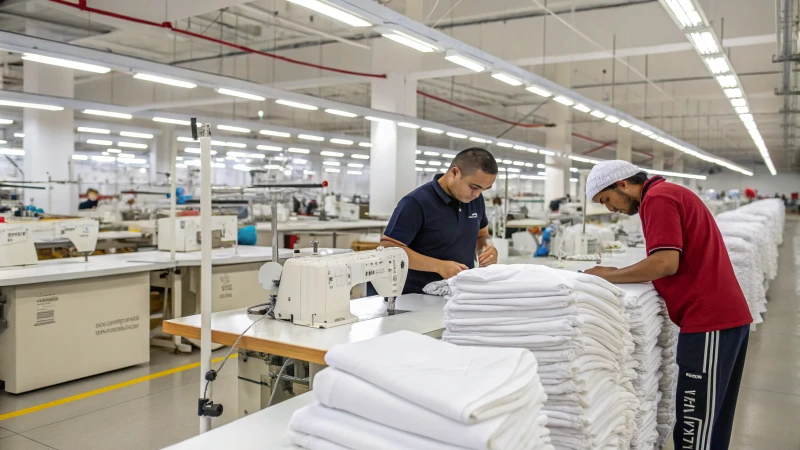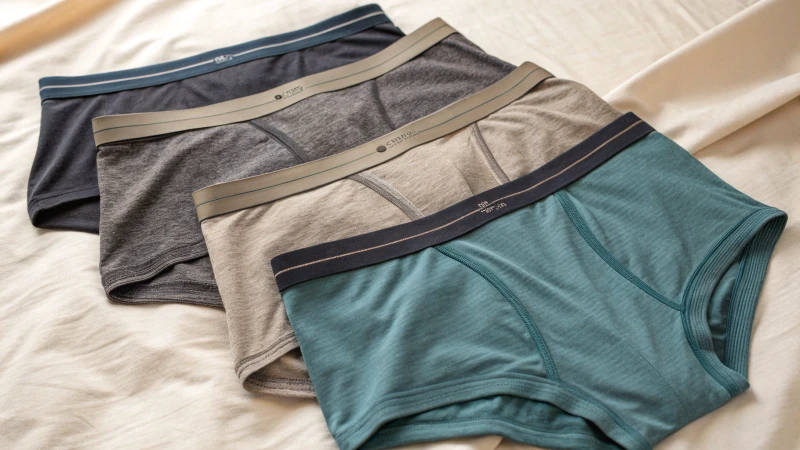
In the quick world of fashion, especially with underwear, I discovered that quality is crucial. Quality is not just a checklist. It is essential for any brand. The stakes are really high. Competition is really strong.
To control quality in large underwear orders, set clear guidelines. Partner with trustworthy suppliers. Inspect thoroughly at each production stage. Using these methods probably reduces defects. Customer satisfaction really increases with fewer defects.
I remember my first big order clearly. Seeing my designs come to life was thrilling. But panic set in when I found defects. I then realized clear instructions were very important. Every detail matters. This includes fabric choice, stitching and packaging. Finding dependable suppliers came next. They needed to understand my vision. Inspecting thoroughly at each step really helped. It let me fix issues before they touched my customers. It’s about more than avoiding errors. It’s about crafting a product I’m proud to support.
Clear specifications are vital for quality control in underwear orders.True
Establishing clear specifications helps ensure that the final product meets quality standards, reducing defects and enhancing customer satisfaction.
Conducting inspections is unnecessary for bulk underwear production.False
Regular inspections at every production stage are essential to identify defects early and maintain high quality in bulk orders.
What Are the Key Steps in Setting Clear Specifications?
Did you ever feel confused during a project because the details were not clear? I have experienced this too! Clear specifications are very important. They help avoid misunderstandings and guarantee project success. Let's explore this topic together.
Setting clear specifications means defining detailed needs. Collaborate with reliable suppliers to achieve this. Ask for samples to check quality. Implement inspections to maintain standards. Establish sizing tolerances for precision. These steps provide clarity. They also guarantee quality in production.

Understanding Clear Specifications
Setting clear specifications resembles constructing a sturdy bridge. Without a solid foundation, everything may fall apart. I learned this hard lesson through personal projects. Vague guidelines created confusion and frustration. I now stick to a structured process so everyone understands the plan. Let me share this process with you!
Step 1: Define Detailed Requirements
Start by outlining all project details. For example, while creating my first product line, I realized how specifics about materials, sizes, stitching, and packaging save time later on. Here’s what to include:
- Materials: Types, qualities, and sources are important.
- Sizes: Offer a size chart for clarity.
- Stitching: Specify required techniques.
- Packaging: Clarify product presentation.
I once made a detailed table for material specifications that looked like this:
| Material Type | Quality Level | Supplier | Cost per Unit |
|---|---|---|---|
| Cotton | Premium | Supplier A | $2.00 |
| Polyester | Standard | Supplier B | $1.50 |
Step 2: Collaborate with Reliable Suppliers
Selecting suppliers who see your vision is important! Rushed partnerships without proper research led to disappointment for me. A strong relationship provides honest feedback and quality assurance. Pick manufacturers who show reliability through past projects. This guide may help find the right supplier.
Step 3: Request Pre-Production Samples
Always ask for samples before committing to full production runs. This provides peace of mind knowing specifications are met. During this phase, check for:
- Design accuracy
- Material quality
- Overall appearance
Use a checklist to evaluate samples:
- Does it match the design brief?
- Are materials as specified?
- Is the fit correct?
Step 4: Implement Quality Control Inspections
Both third-party and in-house inspections proved invaluable for me! They maintain high standards throughout production. Third-party inspections offer unbiased quality views. Here's a simple inspection flowchart:
Pre-Production Samples → Production Monitoring → In-House Inspections → Final Product Review → Post-Shipment SamplingStep 5: Establish Tolerances for Sizing
Defining acceptable sizing ranges ensures a comfortable fit for users. Setting tolerances avoids discrepancies that lead to unhappy customers. Creating a sizing tolerance table helps:
| Size | Tolerance Range |
|---|---|
| S | ±0.5 inches |
| M | ±0.5 inches |
| L | ±0.5 inches |
| XL | ±0.5 inches |
Step 6: Ensure Fabric Quality Checks
Before production, evaluate fabric samples carefully by checking for:
- Durability: Will it last through regular use?
- Feel: Is it comfortable on the skin?
- Stretch: Does it keep shape after stretching?
Involving the design team helps catch potential issues early.
Step 7: Conduct Durability Testing
Testing for shrinkage, colorfastness, and wear resistance is vital. Realizing this helped me see that these tests ensure the product meets customer expectations. My durability tests checklist includes:
- Shrinkage Test
- Colorfastness Test
- Wear Resistance Test
Step 8: Maintain Transparent Quality Control Documentation
Requesting test reports or production logs from suppliers builds trust and accountability throughout the production process using tools like shared documents can help keep everyone informed.
Conclusion We discussed important steps in setting clear specifications that help ensure product quality and alignment among teams following these steps minimizes defects and boosts overall satisfaction Trust me future projects will benefit!
Clear specifications prevent project miscommunication.True
Vague specifications can lead to misunderstandings, resulting in wasted resources and unsatisfactory outcomes. Clear guidelines ensure alignment among teams.
Quality control inspections are unnecessary for production.False
Incorporating quality control inspections is essential to maintain high standards and ensure that products meet specified requirements throughout the production process.
How Can Brands Select Reliable Suppliers for Underwear Production?
Finding the right supplier for underwear production focuses on more than just fabric. It's about forming a partnership that brings your vision to life. This is how I have managed this important process and how you probably could as well.
Brands need to choose trustworthy suppliers for producing underwear. First, they specify their needs. Next, they study possible manufacturers. They also check what these factories can do. It helps to ask for samples. Keeping open communication during the process is really important.

Know Your Needs
Before choosing a supplier, I always clearly define my needs. It's like planning a trip. You wouldn't just drive without knowing where you're going. My checklist includes underwear type, material, size and quality. This really helps me sort possible suppliers.
Look for Suppliers
I search for suppliers using online platforms and industry networks. I focus on those with a good name in underwear. Portfolios and client stories guide me. These stories from other brands really help me check if a supplier is reliable.
Supplier reviews are very valuable. They are like wise words from those who have been through this before.
Check Production Abilities
Not every supplier handles underwear production well. I prioritize checking if a supplier meets my volume needs without losing quality.
I ask about their production steps, machines and workers' skills. This gives me peace of mind. I feel good knowing they can meet my schedule needs.
| Criteria | Importance Level | Supplier A | Supplier B |
|---|---|---|---|
| Production Capacity | High | 50,000/month | 30,000/month |
| Quality Certifications | Medium | ISO 9001 | None |
| Lead Time | High | 4 weeks | 6 weeks |
Ask for Samples
Once I narrow down my choices, I always ask for samples. This step is crucial. Samples let me check the material, stitching and craftsmanship before ordering more.
Samples have saved me from problems. A sample can prevent disappointment if the full order doesn't meet expectations.
Visit Supplier’s Location
If possible, I visit the supplier’s place. Seeing their work firsthand builds a connection. I also check working conditions and quality control in person. It’s like entering their world and understanding their quality commitment.
For more tips on factory visits, see factory visit guidelines.
Communicate Clearly
Clear communication is key. Suppliers must understand my needs. Transparency during production is very important.
Regular updates and feedback improve cooperation. It's like a dialogue that builds trust.
Start Quality Checks
After choosing my supplier, I start strong quality checks. This means inspections during production and checking quality reports after. I use third-party inspection services too. This adds extra trust in product quality, which is really valuable.
Grow Long-Term Relationships
I focus on long-term relationships with suppliers. These relationships lead to better prices, priority service and better cooperation on future projects.
Working together on product development and sharing market ideas is very beneficial for both sides.
For more on supplier relationships, see supplier relationship management.
Brands should outline specific needs before selecting suppliers.True
Defining requirements helps brands filter potential suppliers effectively, ensuring they find the right match for their production needs.
Requesting samples is unnecessary when choosing a supplier.False
Requesting samples is crucial as it allows brands to evaluate quality before placing a full order, preventing future disappointments.
What Role Do Inspections Play in Maintaining Quality During Production?
Do you ever think about how brands check if their products reach the best quality while they are made? Inspections are very important in this job. Inspections help brands like mine stay honest and keep customers very satisfied.
Inspections are very important for keeping quality during production. They find defects early. They also check if standards are met. Moreover, they provide traceability throughout the manufacturing process.

Understanding Quality Inspections
Quality inspections are critical in manufacturing. They help find defects and confirm that products meet set standards. By incorporating inspections at different production stages, I address issues early before they grow.
Importance of Inspections
Preventing Defects: Once, we skipped a crucial inspection step. The result was an entire batch with stitch problems. Regular inspections catch defects early, save time and reduce waste. This is vital in high-stakes industries like fashion, where brand reputation relies heavily on quality.
Compliance with Standards: Inspections verify adherence to industry standards. For brands wanting to stay competitive through quality, following international quality standards1 builds market trust. Trust is vital in this business. Demonstrating it through detailed checks is invaluable.
Documentation and Traceability: Inspections provide a trackable history of product quality. I review inspection records to solve recurring problems. Tracking helps identify patterns and refine processes. It's very beneficial to implement a system for tracking quality2.
Types of Inspections
| Inspection Type | Description | When Conducted |
|---|---|---|
| Pre-Production Samples | Verifying designs and materials before full-scale production. | Before production begins |
| In-Process Inspections | Monitoring production stages to catch defects early. | During production |
| Final Product Review | Comprehensive checks before shipping products. | After production but before shipment |
| Post-Shipment Sampling | Checking a sample of products upon arrival to ensure quality. | After products arrive at destination |
In-House vs. Third-Party Inspections
Deciding between in-house and third-party inspections is crucial for me. This choice depends on factors like cost, expertise and objectivity.
- In-House Inspections: These give immediate feedback and control but sometimes lack objectivity.
- Third-Party Inspections: They provide an unbiased review, crucial for integrity and transparency in quality checks.
Best Practices for Effective Inspections
To improve inspections, consider these best practices that I really value:
- Train Inspectors: Inspectors must be well-trained in standards and techniques.
- Use Technology: Technology streamlines inspections, improving accuracy.
- Continuous Improvement: Regularly reviewing inspection methods helps adapt to market changes and enhances quality.
Using these steps, inspections improve quality control during production, resulting in better products and happier customers. For more insights into effective inspection methodologies, explore inspection best practices3.
Inspections prevent defects in the production process.True
Regular inspections help identify and correct defects early, minimizing waste and ensuring product quality.
Third-party inspections are always more effective than in-house.False
While third-party inspections can provide objectivity, in-house inspections offer immediate feedback; effectiveness depends on context.
What Are the Common Challenges in Quality Control for Underwear?
Exploring the world of underwear production is very delicate and intricate. I have faced many challenges in this field. Understanding these problems helps producers like me give customers the quality they deserve. Let's dive into these hurdles together.
Quality control for underwear encounters challenges such as picking the right materials, dealing with sizing differences and trusting suppliers. Production supervision is another big obstacle. Checking customer opinions is also a challenge. Solving these problems is crucial for keeping high standards. Customers need to be happy.

Material Selection Challenges
Quality control in underwear isn't only about finding defects; it's a path filled with complex challenges that could really affect the final product. The first step in quality control starts with choosing materials. It’s like picking the perfect ingredients for a recipe. One wrong choice might ruin everything. Once, I chose a beautiful cotton blend for a new line. It was soft and breathable, yet I quickly learned it lacked the necessary stretch. Frustration was strong when we got customer complaints about the fit.
To avoid such problems, manufacturers can conduct fabric quality checks4 to evaluate samples before mass production. Testing properties like:
| Property | Description | Testing Method |
|---|---|---|
| Durability | Resistance to wear and tear | Abrasion tests |
| Colorfastness | Retention of color after washing | Wash tests |
| Stretchability | Ability to maintain shape under tension | Stretch tests |
These checks hold importance for keeping consistency. Customers need to receive what they expect.
Sizing and Fit Issues
Another big challenge is finding the right fit for various sizes. It’s like finding the perfect pair of jeans; too tight or too loose might lead to disappointment. Establishing tolerances for sizing has been very crucial here. For instance:
| Size | Tolerance Range (inches) |
|---|---|
| S | ±0.5 |
| M | ±0.75 |
| L | ±1 |
Once, a popular design was returned in large numbers because it ran small, and my heart sank knowing the effort in creating that line.
A robust inspection process at every production step helps customers find a perfect fit.
Supplier Reliability and Communication
Suppliers can greatly affect quality control efforts. If communication fails, the final product might not meet expectations. Once, miscommunication led to receiving the wrong fabric completely! Regular talks about quality standards have been my saving path.
Engaging in regular dialogue with suppliers about quality standards and production timelines helps prevent misunderstandings. Utilizing third-party QC inspections5 has given unbiased assessments of product quality during and after production, ensuring alignment with our brand's high standards.
Production Process Oversight
Finding problems early in production is essential for keeping quality. I now regularly include these practices:
- Conduct pre-production sample reviews to check design and material suitability.
- Implement in-house inspections during the manufacturing process to maintain standards.
- Perform post-shipment sampling to catch defects before reaching customers.
These practices have become key parts of my quality control approach; each product needs to reflect our commitment to excellence.
Customer Feedback Integration
Customer feedback is really critical for improving quality control processes. Analyzing insights on fit, comfort, and durability reveals recurring issues I might miss. Employing this feedback loop allows brands to adjust their strategies continuously, enhancing overall product satisfaction.
Once, a beloved line turned uncomfortable over time; feedback led me to refine materials, improving overall satisfaction while addressing common complaints through common complaints6. We aim not only to meet but exceed customer expectations.
Cotton is more breathable than synthetic fabrics for underwear.True
Cotton offers superior breathability compared to synthetic materials, making it a preferred choice for comfort in underwear production.
Supplier communication does not impact quality control in production.False
Effective communication with suppliers is crucial to ensure that materials and designs meet quality standards, impacting overall product quality.
Conclusion
Effective quality control in bulk underwear production involves clear specifications, reliable suppliers, thorough inspections, and customer feedback integration to minimize defects and boost satisfaction.
Discover effective inspection strategies that can enhance your production quality management. ↩
Learn how technology can improve inspection processes for better quality assurance. ↩
Explore best practices for implementing effective inspections in your production workflow. ↩
Learn how to overcome common challenges in quality control for underwear manufacturing to enhance your brand's reputation. ↩
Discover best practices for managing sizing and fit issues in underwear production. ↩
Explore strategies to improve communication with suppliers for better quality outcomes. ↩






